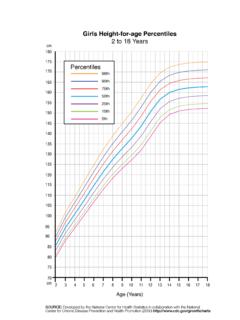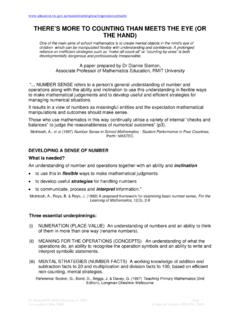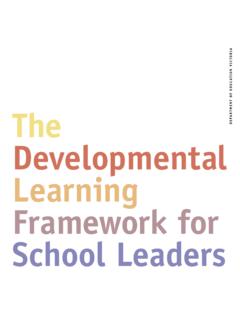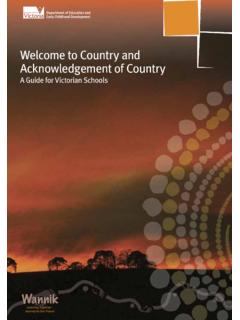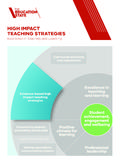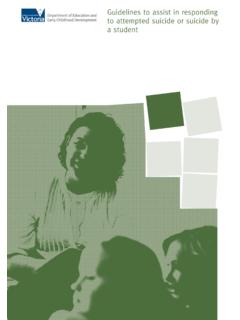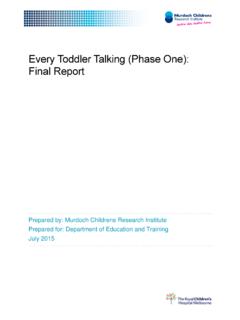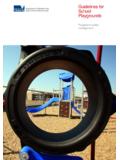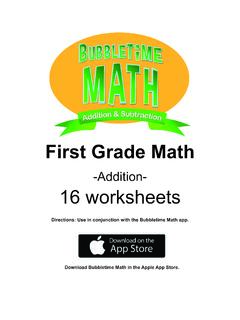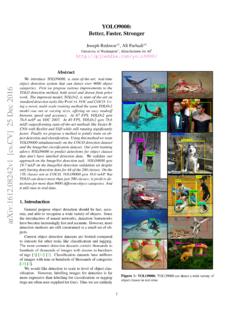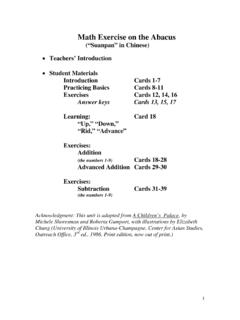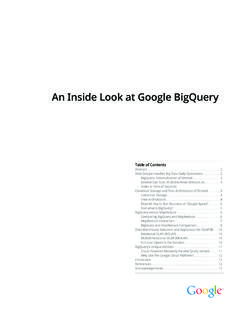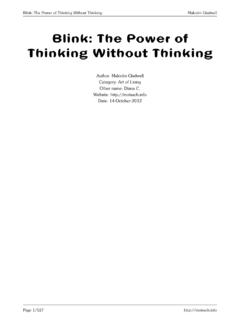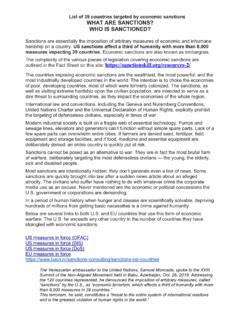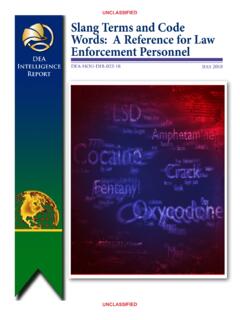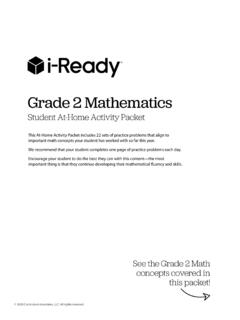Transcription of HIGH IMPACT TEACHING STRATEGIES - Department of …
1 1 | high IMPACT TEACHING STRATEGIESE xcellence in TEACHING and LearningCurriculum planning and assessmentEvaluating IMPACT on learningParents and carers as partnersGlobal citizenshipNetworks with schools, services and agenciesBuildingcommunitiesBuilding practiceexcellencePositive climate for learningProfessionalleadershipCommunity engagement in learningStudent achievement, engagement and wellbeingEmpowering students and building school prideHealth and wellbeingSetting expectations and promoting inclusionIntellectual engagement and self awarenessInstructional and shared leadershipStrategic resource managementVision values and cultureBuilding leadership teamsExcellence in TEACHING and learningEvidence-based high IMPACT TEACHING strategies2 | high IMPACT TEACHING STRATEGIES State of Victoria First published by the Deaperment of Education and Training, Melbourne June2017.
2 Revised and updated October IMPACT TEACHING STRATEGIES Excellence in TEACHING and learning is provided under a Creative Commons Attribution International licence. You are free to re-use the work under that licence, on the condition that you credit the State of Victoria ( Department of Education and Training), indicate if changes were made and comply with the other licence terms, see: Creative Commons Attribution International The licence does not apply to: any images, photographs, trademarks or branding,including the Victorian Government logo and the DETlogo; and content supplied by third queries may be directed to 978-0-7594-0820-32 | high IMPACT TEACHING StrategiesHigh IMPACT TEACHING STRATEGIES | 3 ContentsIntroduction4 What are the high IMPACT TEACHING STRATEGIES (HITS)?
3 5 This resource offers: 5 What is effect size? 5 Who are the HITS for? 6 Teachers 6 Professional learning communities 6 School leaders 6 Using the HITS 7 Providing feedback 7 HITS overview table 8 Setting Goals 10 Structuring Lessons 12 Explicit TEACHING 14 Worked Examples 16 Collaborative Learning 18 Multiple Exposures 20 Questioning22 Feedback24 Metacognitive STRATEGIES 26 Differentiated TEACHING 284 | high IMPACT TEACHING StrategiesWhen teachers work together to improve their practice, students learn more. This simple yet powerful idea is at the heart of effective schools. Collaboration builds collective responsibility for constantly improving TEACHING practice and so student learning.
4 The challenge for teachers and schools is to develop a shared understanding of what excellent practice looks like. While it will not look exactly the same in every classroom, there are some instructional practices that evidence suggests work well in high IMPACT TEACHING STRATEGIES (HITS) have been brought together here to support the thousands of increasingly collaborative and evidence-based conversations taking place between teachers in schools each day. These STRATEGIES provide teachers and teams with opportunities to observe, reflect on and improve a range of fundamental classroom practices. The HITS are not intended to replace other TEACHING STRATEGIES teachers might already use with success.
5 Instead, they will add to the repertoire of effective STRATEGIES that teachers can apply to the wide variety of learning needs that students present with each 2016, school leadership teams have drawn on the Framework for Improving Student Outcomes (FISO) to drive strategic and annual planning at the whole school level. By clearly and insistently directing that planning toward student learning, FISO is helping to identify and address persistent challenges for individual teachers and to build collective teacher efficacy. The HITS provide a clear link between the Evidence Based high IMPACT TEACHING STRATEGIES dimension of FISO and classroom practice. Teachers can plan and adjust their practice in response to one or more of the HITS and monitor the IMPACT on student engagement and learning outcomes.
6 This resource provides a focus for the professional development efforts of individual teachers, which can be linked to the goals and feedback components of their own Performance and Development Plans. Teachers in all schools are encouraged to use the HITS to challenge themselves and their colleagues as part of our collective and ongoing commitment to improving learning outcomes for every Victorian planning and assessmentEvidence-based high IMPACT TEACHING strategiesEvaluating IMPACT on learningParents and carers as partnersGlobal citizenshipNetworks with schools, services and agenciesBuildingcommunitiesBuilding practiceexcellenceExcellence in TEACHING and learningPositive climate for learningProfessionalleadershipCommunity engagement in learningStudent achievement.
7 Engagement and wellbeingEmpowering students and building school prideHealth and wellbeingSetting expectations and promoting inclusionIntellectual engagement and self awarenessInstructional and shared leadershipStrategic resource managementVision values and cultureBuilding leadership teamsHigh IMPACT TEACHING STRATEGIES | 5 What are the high IMPACT TEACHING STRATEGIES (HITS)? The HITS are 10 instructional practices that reliably increase student learning wherever they are applied. They emerge from the findings of tens of thousands of studies of what has worked in classrooms across Australia and the world. International experts such as John Hattie and Robert Marzano have synthesised these studies and ranked hundreds of TEACHING STRATEGIES by the contribution they make to student learning [see What is effect size?]
8 Box]. The HITS sit at the top of these rankings. Some teachers will ask, But will they work in my classroom, with my students? Only the professional judgement of teachers, both individual and collective, can answer that question. For any concept or skill that students need to learn, using a HITS to teach it increases the chances that students will learn it, compared to using other STRATEGIES . But they are reliable, not infallible. Knowing their students and how they learn, teachers are well-placed to judge whether a HITS or another strategy is the best choice to teach that concept or skill. The HITS will not be new to most teachers. The purpose of this resource is to bring them together in one place, along with practical examples of how other Victorian teachers are using them successfully.
9 The HITS alone do not constitute a complete framework for professional practice. They are part of the full set of instructional practices that contribute to a comprehensive pedagogical model [see diagram below].What is effect size?Effect size is a measure of the contribution an education intervention makes to student learning. It allows us to move beyond questions about whether an intervention worked or not, to questions about how well an intervention worked in varying contexts. This evidence supports a more scientific and rigorous approach to building professional regarded educational researchers and resources, including Hattie, Lemov, Marzano, and the TEACHING and Learning Toolkit*, have used slightly different methodologies to measure effect size and identify HITS.
10 Despite their varied approaches and terminology, all agree on a number of powerful STRATEGIES . These STRATEGIES are reflected in this HITS resource and the AITSL Standards and the Classroom Practice Continuum.* Evidence for Learning (2017) TEACHING and Learning Toolkit -Australia. resource offers: accessible, succinct guidance on using highimpact, evidence-based STRATEGIES bite sized insights that enable you to focuson one or more HITS, and to progressivelybuild expertise, and scalable possibilities, allowing individualteachers, Professional LearningCommunities, and whole schools, to setgoals and actions centred on the ModelInstructional PracticesHITS6 | high IMPACT TEACHING StrategiesWho are the HITS for?
